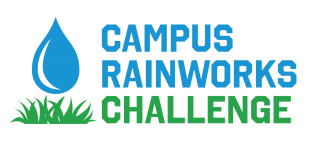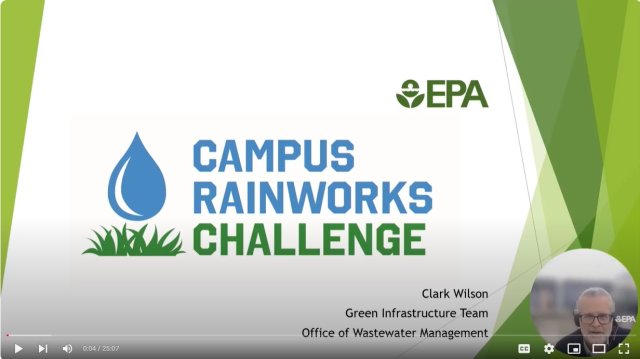Campus RainWorks Challenge

On this page:
About the Challenge
The Campus RainWorks Challenge is a green infrastructure design competition for American colleges and universities. It seeks to engage with the next generation of environmental professionals, foster a dialogue about the need for innovative stormwater management techniques, and showcase the environmental, economic, and social benefits of green infrastructure.
"Green infrastructure" refers to a variety of practices that restore or mimic natural hydrological processes. While "gray" stormwater infrastructure is largely designed to convey stormwater away from the built environment, green infrastructure uses soils, vegetation, and other media to manage rainwater where it falls with capture and evapotranspiration techniques. By integrating natural processes into the built environment, green infrastructure provides a wide variety of community benefits, including improving water and air quality, reducing urban heat island effects, creating habitat for pollinators and other wildlife, and providing aesthetic and recreational value. For more information, see About Green Infrastructure.
Read this case study to learn more about how a University of Pennsylvania Campus RainWorks Challenge team (pdf) implemented part of their winning design.
Stormwater runoff is a significant source of water pollution in communities across the United States. The Campus RainWorks Challenge invites students to be part of the solution today and in the future.
To sign up for email updates or ask a question about the Campus RainWorks Challenge, email [email protected].
Does your school have what it takes to win? Step up to the challenge!
Students Tell Their Stories
Tune in to a webinar with the University of Oregon team, 2023 first place winners, to hear about their experience participating in Round 11 of the challenge.

Learn more from Campus RainWorks alumni about the benefits they experienced from participating in the challenge.
Elizabeth Smith
Campus RainWorks Project: Year 6 (Master Plan), Spelman College
Current Position: PhD student in Plant and Soil Science at University of Delaware
Favorite Type of Green Infrastructure: Rooftop Gardens
How did your Campus RainWorks experience influence your career path or further education?
It made me realize that I need a little more experience. I was teetering between going to grad school and going straight into industry. Working on the project I realized that I knew a little, but I’d like to know a little bit more. It also taught me that project management is a very important skill that I would like to hone, and I mentioned that when applying to grad school.
What would you like future students to know about participating in Campus RainWorks?
It’s a really good practice to put an idea together and work through it. To work through the scientific method, identify a problem with a group of people, and find solutions to that problem. Especially as you apply for jobs and they ask for examples of a work piece, it’s a really great example of what you can do, how well you work with a team, and how you apply skills.
Edith Martinez-Guerra, PhD, PE
Campus RainWorks Project: Year 2 Second Place Winner (Site Design), Mississippi State University
Current Position: Research Environmental Engineer
Favorite Type of Green Infrastructure: Rain Garden
What technical skills did you gain from participating in Campus RainWorks?
Participating in Campus RainWorks helped me to really understand the calculations I had learned in class. After competing in Campus RainWorks all the stormwater calculations made sense, and now when it rains, I can see the different types of stormwater flow and how to calculate them.
How did your Campus RainWorks experience prepare you for your career?
As a researcher, I work in teams. Campus RainWorks taught me how to own my tasks and be conscious of other people’s time while working as a team with a deadline. I also learned the importance of making the end result of a team project look cohesive even though many different people worked on it.
Jessica Wiegand
Campus RainWorks Project: Year 6 First Place Winner (Demonstration Project), University of Illinois at Urbana-Champaign
Current Position: Water Resources Engineer
Favorite Type of Green Infrastructure: Rain Garden
What influence did working with different disciplines have on your project?
We started out with mostly civil engineers, but when we got landscape architects involved it really opened a new door. Not only did we have a functional project, but something that was actually beautiful and people would want to come see. We also had a biologist that could think more about what plants we incorporated, and someone who helped us with writing. It helped us think outside the box and see the project from different angles.
What would you like future students to know about participating in Campus RainWorks?
I would tell them it’s a great resume builder. It’s a great way to work on your communication skills, dive into some design-type work, and grow your network. Also, since your team is probably going to be a small group, you can have a lot of ownership in the project.
Linlong Bian, PhD
Campus RainWorks Project: Year 8 First Place Winner (Master Plan), Florida International University
Current Position: Water Resources Engineer
Favorite Type of Green Infrastructure: Bioretention Pond
What made you want to participate in the Campus RainWorks Challenge?
There were three factors. One, my major was water resources management which included green infrastructure, and I thought the challenge would be a good chance for me to apply what I had learned. I also learned from others to improve myself. Second, my supervisor encouraged us that it would help us with our careers in the future because everybody knows EPA. And third, because the competition attracts a lot of talented students from many schools.
What job-related skills did you gain from participating in Campus RainWorks?
It was my first time being a team lead and the role helped me feel more comfortable interacting with people from different perspectives, and how when you talk with different disciplines the way they think about a problem is going to be different. The most valuable thing I learned was that if you want to become a really good team lead you have to focus on people’s emotions.
Nusrat Jahan Nipu
Campus RainWorks Project: Year 9 First Place Winner (Master Plan), University of Texas at Arlington
Current Position: Landscape Designer
Favorite Type of Green Infrastructure: Rain Garden
How did participating in Campus RainWorks change how you think about stormwater and green infrastructure?
At the beginning of my master’s degree in landscape architecture, I thought landscaping was only for beautification or attracting people, like a park. But in this competition, I learned it’s not like that; landscaping has a great contribution to the environment, like stormwater management with bioswales and rainwater gardens.
How does your current position involve green infrastructure?
As an intern, I visited an apartment complex with a poor drainage system and presented to my employer about the rain garden system, how it works, and how it’s maintained. Unfortunately, they didn’t know about rain gardens, but after my presentation they wanted to build one to solve that stormwater problem.
Mrinalini Verma
Campus RainWorks Project: Year 9 First Place Winner (Demonstration Project), University of Pennsylvania
Current Position: Landscape Designer and Sustainability Specialist
Favorite Type of Green Infrastructure: Any green infrastructure the community feels is their own.
What influence did working with different disciplines have on your project?
When I came into this group, everyone there—people from business school, design school, environmental studies—helped me think about issues from different perspectives and helped me think about co-benefits that you wouldn’t necessarily think about as a landscape architect. Different disciplines are very siloed sometimes, so it was an interesting opportunity.
What skills did you gain from participating in Campus RainWorks?
I learned economics. Campus RainWorks is not just a competition for us, we are actually implementing projects on the ground, so funding is a big part of it. I learned how you do cost estimates and how you approach different funding opportunities.
Lauren Lambert
Campus RainWorks Project: Year 7 First Place Winner (Master Plan), University of Louisiana at Lafayette
Current Position: Architectural Designer
Favorite Type of Green Infrastructure: Rain Garden
What is one of your favorite memories from participating in Campus RainWorks?
After we completed the project, it was really cool to see the university’s response to it. We had presented our project to the President’s Sustainability Council and especially after we won, they are taking it more seriously and are really trying to incorporate the things we talked about on this master plan. As someone in the field of architecture, it’s really rewarding that all the hard work we did is paying off, and to see our design being used and helping the environment.
What advice would you give to potential participants in the future?
To just go for it, and really try to build a diverse team. I think the diverse team really helped us. You don’t know everything, so just to admit that and find people. You meet new people that way as well and you learn a lot from each other. That was what I really took away, is learning a lot from my peers during this project.
Binita Mahato, PhD
Campus RainWorks Project: Year 5 Second Place Winner (Master Plan), University of Cincinnati
Current Position: Assistant Professor
Favorite Type of Green Infrastructure: Green Roofs
How did your Campus RainWorks experience influence your career path?
Our instructor insisted that we not look at the project as just a competition, but also use it to know how different disciplines take part in green infrastructure. I always wanted to use this as a way forward for my research. Building on that, I like to do research on social justice. This project had that aspect and helped me think about how green construction can benefit all, not just a certain group of people.
How does your current position involve green infrastructure?
I designed a course, which is called Sustainable Urbanism, and it built on green infrastructure. My teaching is mostly urban design courses, and this one brings in the sustainable perspective, towards the design and planning in general. The students are also asked to work on the Campus RainWorks competition as part of the class.
Willis Logsdon
Campus RainWorks Project: Year 6 First Place Winner (Master Plan), University of California Berkeley
Current Position: Urban Watershed Planner
Favorite Type of Green Infrastructure: Green infrastructure in school yards
What did you take away from participating in Campus RainWorks?
Working with a team that has different skill sets and learning how to translate between disciplines is something I gained: for example, translating technical modeling data into graphics, or design solutions into a model with realistic results. Even today, a lot of my projects with green infrastructure are very interdisciplinary, and it’s an important skill to have.
Did you use your Campus RainWorks experience during your job search after graduating?
Definitely. It was at the top of the list of my educational background and achievements on my resume. It was a good thing to highlight and have as a talking point. Thinking about some of the interview questions that come up when you are coming out of college, a lot of them are asking about examples of projects you worked on, and this was a great example to lean on.









